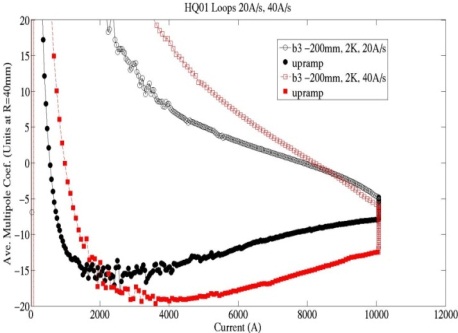![]() Successful test of HQ02: Nb3Sn is getting closer to proton beams
Successful test of HQ02: Nb3Sn is getting closer to proton beams


Fig.1, left: Ramp rate dependence of b3 on HQ01 without cored cable. Image credit: LARP collaboration.
Fig.2, right: Ramp rate dependence of b3 in HQ02 with cored cable. Image credit: LARP collaboration.
US LHC Accelerator Research Program (LARP) scientists in collaboration with CERN under the framework of HiLumi LHC are working on the development of the Nb3Sn technology to produce accelerator magnets that are able to operate at 12 T peak field in the coil. After the first successful test of HQ02 further tests are on-going to test other critical aspects of the magnet.
HQ02 is the first magnet that makes use of a “cored” cable, i.e. a 25-mm-thick strip between the superconducting strands to increase the resistance between strands. In case of Nb-Ti LHC magnets, the interstrand resistance was controlled through an oxidation of the strands. This method cannot be used for the Nb3Sn which becomes superconductive after a heat treatment at 650 ºC lasting more than one day. First results show that the field quality versus current is extremely smooth compared to the behaviour of a magnet without cored cable. The core also allows reducing the heating induced by a fast ramping, so that the magnet is superconductive even at ramp rate higher than nominal.
In its first test, HQ02 reached the power supply limit of 15 kA, corresponding to operational current at 1.9 K, with a few quenches. The second powering is being done at 2.2 K, after a warm up and cool down, showing a perfect memory (i.e. the magnet was able to reach the same current as before warm up without any quench), and capability of operating at 16 kA, i.e. a margin of 1 kA. The powering is still in progress and a special program is now on-going to test other critical aspects as quench protection. The new inner triplet to be installed at the beginning of next decade will be based on this design, taking all the features that have been successfully proved by LARP.
